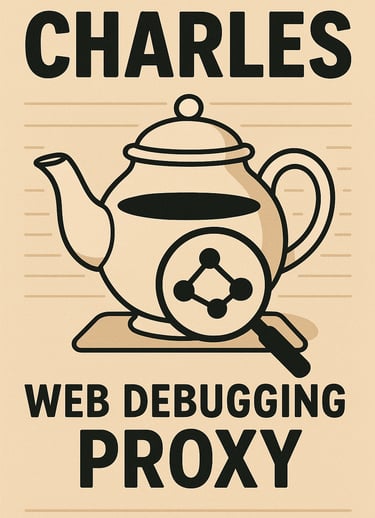Free Charles Web Debugging Proxy v5.0.3 Full Activated SSL
10/12/20257 min read


Charles Web Debugging Proxy 2025 Activated
Charles Web Debugging Proxy 2025 is a powerful tool designed to facilitate the debugging of web applications by monitoring HTTP and HTTPS traffic. As an essential resource for web developers and software testers, Charles enables users to capture and inspect data transmitted between a client and a server. This critical functionality allows developers to identify issues in real time, ensuring that applications perform as expected during the development phase.
One of the most significant advantages of utilizing Charles is its ability to simplify the debugging process. By providing an intuitive interface, users can easily analyze requests, responses, and the relative timing of transactions. This level of transparency not only accelerates the identification of issues but also enhances communication among team members by illustrating how data flows within an application. Furthermore, Charles offers a variety of features such as breakpoints, which allow developers to pause and modify requests or responses, aiding in the diagnosis of problematic areas within web applications.
Charles Web Debugging Proxy also supports multiple platforms and devices, enabling developers to debug applications across various operating systems and mobile devices seamlessly. This cross-platform compatibility means that teams are not restricted to a single environment, further streamlining the development process. Additionally, the tool offers capabilities such as SSL proxying, which allows users to view encrypted HTTPS traffic, providing deeper insights into the application's communications.
In a world where rapid development cycles and high-quality standards are paramount, tools like Charles are indispensable. Whether you are a seasoned developer or a novice, mastering this debugging proxy can significantly enhance your ability to assess and optimize web applications effectively.
Key Features of Charles v5.0.3
Charles Web Debugging Proxy v5.0.3 full Activated is a powerful tool designed for developers and testers who need to analyze their web applications efficiently. One of its standout features is SSL proxying, which allows users to monitor and modify the HTTPS requests that are typically encrypted. This functionality is crucial for debugging APIs and web services securely, as it provides clear visibility into the encrypted traffic, helping developers identify issues related to performance or data security with ease.
Another significant feature of Charles v5.0.3 is bandwidth throttling. This tool enables users to simulate different network conditions by controlling the speed of their internet connection. By mimicking slower connections, developers can evaluate how their web applications perform under various speeds, ensuring that they are optimized for all users, regardless of their network environments. This capability is essential in today's diverse digital landscape, where connectivity can vary dramatically among users.
Charles also offers support for various platforms, including Windows, macOS, and Linux. This cross-platform compatibility means that developers can seamlessly integrate Charles into their existing workflows, regardless of the operating systems they use. The multi-platform support facilitates debugging in mixed-environment setups and helps teams work more effectively without the need for additional tools.
In addition to these features, Charles v5.0.3 includes a user-friendly interface designed to streamline the debugging process. Its straightforward navigation allows users to quickly access the necessary functions, making it easier to diagnose and resolve issues in real-time. By combining these key features, Charles Web Debugging Proxy v5.0.3 presents a robust solution for developers looking to enhance their application troubleshooting capabilities.
Installation and Setup Process
The installation and setup of Charles Web Debugging Proxy v5.0.3 is a straightforward process designed for users of varying technical backgrounds. Before proceeding, ensure that your system meets the minimum requirements for optimal performance. Charles is compatible with Windows, macOS, and Linux operating systems. For Windows, a minimum of 4GB RAM and 500MB of disk space is recommended. Mac users should also have at least 4GB of RAM, with 500MB disk space, while for Linux, similar specifications apply.
To download Charles v5.0.3, navigate to the official Charles Proxy website. Locate the download section and select the appropriate version for your operating system. After the download is complete, locate the installer file on your system. For Windows, this will be an executable (.exe) file, while Mac users will find a disk image (.dmg) file, and Linux users will typically encounter a tar file. Double-click the installer and follow the on-screen instructions to initiate the installation process.
Once installed, it is crucial to configure the initial settings to maximize the benefits of Charles. Upon launching the application, users will be greeted with the welcome screen. The first step is to check for any updates to ensure that you are using the latest version with all security patches and features. Next, users should configure the proxy settings. By default, Charles will automatically set the system proxy to allow intercepting and monitoring HTTP/S traffic seamlessly. Verify the settings by testing a connection in your browser.
Additionally, you may want to customize various preferences according to your debugging needs. This includes adjusting the recording settings, specifying the SSL proxying for HTTPS traffic, and managing cookies and sessions effectively. Once these configurations are completed, users will be well-equipped to begin utilizing Charles Web Debugging Proxy v5.0.3 to capture and analyze network traffic efficiently.
How to Effectively Use Charles for Debugging
Utilizing Charles Web Debugging Proxy for effective debugging requires a strategic approach to capture and analyze network traffic efficiently. To begin, ensure that the application or device you wish to debug is configured to route its traffic through Charles. This is typically achieved by setting up the appropriate proxy settings, allowing Charles to intercept the request and response data seamlessly.
Once you have set up Charles, capturing data is simple. Initiate the application or web service, and monitor the traffic within Charles. You'll observe a detailed list of requests and responses, including HTTP headers and bodies. Analyzing this data is critical as it reveals useful insights into how your application is interacting with external services. Pay special attention to status codes, response times, and the size of the payloads, which can help identify potential bottlenecks or issues.
In addition to capturing data, modifying headers can greatly enhance your debugging capabilities. Charles allows you to edit requests on the fly, enabling you to test how the application responds under different conditions. This can be particularly useful for simulating different user environments or diagnosing authentication issues. For instance, by modifying the User-Agent string, you can observe how the server responds to different devices.
Simulating various network conditions is another powerful feature of Charles. By using the built-in throttling and bandwidth simulation tools, you can replicate scenarios like slow connections or high latency. This can help uncover performance issues that may not be evident during normal testing. Implementing these strategies will not only improve your debugging skills but will also empower you to handle complex issues more effectively.
Common Use Cases for Charles Web Debugging Proxy
The Charles Web Debugging Proxy serves as an invaluable tool for developers, offering a variety of use cases that address common challenges in modern web development. One of the primary scenarios where Charles excels is in identifying performance bottlenecks within applications. By monitoring network calls, developers can pinpoint which requests are taking longer than expected, allowing them to take corrective action. This feature is particularly useful for optimizing loading times and ensuring a seamless user experience.
Another significant use case involves API testing. As microservices and APIs become integral to application architecture, Charles allows developers to inspect the data being sent and received. It provides the capability to simulate different network environments, yielding insights on how various conditions affect API performance, thereby enabling thorough testing before deployment. This also helps in validating API responses against expected outcomes, ensuring that any discrepancies can be resolved promptly.
In addition to performance monitoring and API testing, Charles facilitates in-depth debugging of web pages. When developers encounter issues such as broken links or loading errors, Charles can be used to analyze the traffic between the browser and the server, isolating the root cause of such problems. This level of detail is crucial in rectifying glitches efficiently. Furthermore, Charles assists with SSL proxying, permitting developers to inspect HTTPS requests. By decrypting SSL traffic, developers can analyze secure data exchanges, which is often a source of confusion during debugging sessions.
Moreover, Charles can be used for network throttling. This feature enables developers to test how applications behave under various network conditions, thus gaining insights into accessibility issues for users with slower internet connections. Each of these use cases exemplifies the adaptability and essential functionality of Charles Web Debugging Proxy in addressing the multifaceted challenges developers face today.
Troubleshooting Common Issues
Users of Charles Web Debugging Proxy v5.0.3 may encounter various issues that can impede their debugging efforts. Understanding these typical problems and their solutions can greatly enhance user experience. One common issue involves connection problems, where Charles may struggle to connect to certain applications or services. Users should first ensure that Charles is properly configured to capture traffic. This may involve verifying proxy settings in the application and ensuring that they match those in Charles. Additionally, users should check if their firewall or antivirus software is inadvertently blocking Charles, which can prevent successful connections.
SSL certificate errors also frequently arise during the use of Charles. Such errors occur when secure connections to websites are disrupted, often due to the absence of valid SSL certificates in Charles. To resolve this, users need to install the Charles Root Certificate on their device. This process typically involves navigating to the application preferences, selecting the SSL tab, and following the prompts to install the certificate. Upon successful installation, users must also confirm that their system trusts this certificate and may need to adjust settings in web browsers or devices to ensure proper SSL decryption.
Another notable issue pertains to performance lags during debugging sessions. This can stem from capturing excessive amounts of data, which may overwhelm the system's resources. To mitigate this, users are encouraged to filter captured traffic appropriately by using the session menu to exclude certain domains or protocols that are not pertinent to their debugging needs. Furthermore, regularly clearing the session data can help maintain optimal performance. By being aware of these common challenges and their corresponding solutions, users can navigate the debugging process more effectively with Charles Web Debugging Proxy v5.0.3.
Conclusion and Future Outlook
In conclusion, the analysis presented in this blog post underscores the significant role that tools like Charles Web Debugging Proxy v5.0.3 play in the realm of modern web development. Throughout the exploration, we highlighted key features, practical applications, and the inherent benefits that this debugging proxy offers to developers. By facilitating efficient HTTP/HTTPS traffic monitoring and providing insightful information, Charles enables developers to identify and troubleshoot network issues with greater ease and effectiveness. Thus, integrating such tools into the development process is crucial for optimizing web applications and ensuring a seamless user experience.
As we venture into the future, the landscape of web debugging technologies is likely to evolve further, keeping pace with the rapid advancements in web development frameworks and methodologies. Potential updates in versions of Charles, as well as novel tools in this domain, may bring enhanced capabilities such as improved user interfaces, AI-driven analytics, and more robust security features. Additionally, an increasing emphasis on collaboration and cloud-based solutions is expected to shape the next generation of debugging tools, enabling developers to work collectively and share insights more efficiently.
For developers and teams committed to staying ahead of the curve, embracing continuous learning and experimentation with emerging web debugging technologies will be pivotal. By doing so, they can harness the full potential of tools like Charles Web Debugging Proxy and adapt to the growing complexities of web applications. The journey of discovery does not end here; it is essential to remain vigilant, exploring new features and methodologies, which will ultimately lead to more effective and resilient web development practices.
Tools
Explore our innovative tech and software solutions.
Gmail
Support
© 2025. All rights reserved.
